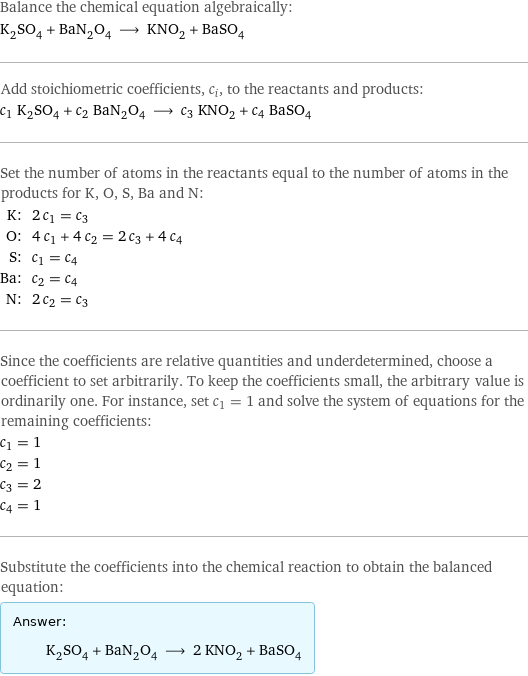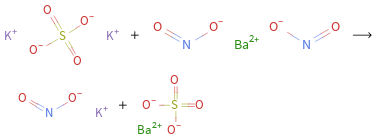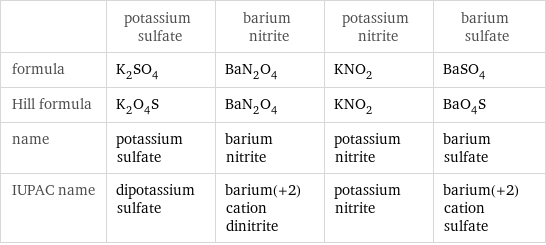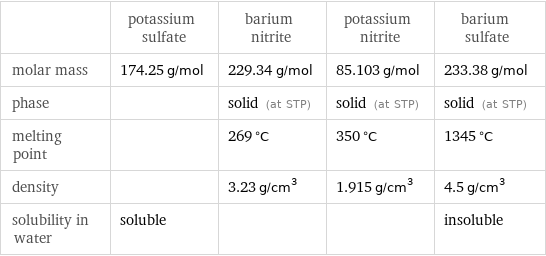Input interpretation

K_2SO_4 potassium sulfate + BaN_2O_4 barium nitrite ⟶ KNO_2 potassium nitrite + BaSO_4 barium sulfate
Balanced equation

Balance the chemical equation algebraically: K_2SO_4 + BaN_2O_4 ⟶ KNO_2 + BaSO_4 Add stoichiometric coefficients, c_i, to the reactants and products: c_1 K_2SO_4 + c_2 BaN_2O_4 ⟶ c_3 KNO_2 + c_4 BaSO_4 Set the number of atoms in the reactants equal to the number of atoms in the products for K, O, S, Ba and N: K: | 2 c_1 = c_3 O: | 4 c_1 + 4 c_2 = 2 c_3 + 4 c_4 S: | c_1 = c_4 Ba: | c_2 = c_4 N: | 2 c_2 = c_3 Since the coefficients are relative quantities and underdetermined, choose a coefficient to set arbitrarily. To keep the coefficients small, the arbitrary value is ordinarily one. For instance, set c_1 = 1 and solve the system of equations for the remaining coefficients: c_1 = 1 c_2 = 1 c_3 = 2 c_4 = 1 Substitute the coefficients into the chemical reaction to obtain the balanced equation: Answer: | | K_2SO_4 + BaN_2O_4 ⟶ 2 KNO_2 + BaSO_4
Structures

+ ⟶ +
Names

potassium sulfate + barium nitrite ⟶ potassium nitrite + barium sulfate
Equilibrium constant
![Construct the equilibrium constant, K, expression for: K_2SO_4 + BaN_2O_4 ⟶ KNO_2 + BaSO_4 Plan: • Balance the chemical equation. • Determine the stoichiometric numbers. • Assemble the activity expression for each chemical species. • Use the activity expressions to build the equilibrium constant expression. Write the balanced chemical equation: K_2SO_4 + BaN_2O_4 ⟶ 2 KNO_2 + BaSO_4 Assign stoichiometric numbers, ν_i, using the stoichiometric coefficients, c_i, from the balanced chemical equation in the following manner: ν_i = -c_i for reactants and ν_i = c_i for products: chemical species | c_i | ν_i K_2SO_4 | 1 | -1 BaN_2O_4 | 1 | -1 KNO_2 | 2 | 2 BaSO_4 | 1 | 1 Assemble the activity expressions accounting for the state of matter and ν_i: chemical species | c_i | ν_i | activity expression K_2SO_4 | 1 | -1 | ([K2SO4])^(-1) BaN_2O_4 | 1 | -1 | ([BaN2O4])^(-1) KNO_2 | 2 | 2 | ([KNO2])^2 BaSO_4 | 1 | 1 | [BaSO4] The equilibrium constant symbol in the concentration basis is: K_c Mulitply the activity expressions to arrive at the K_c expression: Answer: | | K_c = ([K2SO4])^(-1) ([BaN2O4])^(-1) ([KNO2])^2 [BaSO4] = (([KNO2])^2 [BaSO4])/([K2SO4] [BaN2O4])](../image_source/7dcec44e7bb150eeaf1838da5ce2e65c.png)
Construct the equilibrium constant, K, expression for: K_2SO_4 + BaN_2O_4 ⟶ KNO_2 + BaSO_4 Plan: • Balance the chemical equation. • Determine the stoichiometric numbers. • Assemble the activity expression for each chemical species. • Use the activity expressions to build the equilibrium constant expression. Write the balanced chemical equation: K_2SO_4 + BaN_2O_4 ⟶ 2 KNO_2 + BaSO_4 Assign stoichiometric numbers, ν_i, using the stoichiometric coefficients, c_i, from the balanced chemical equation in the following manner: ν_i = -c_i for reactants and ν_i = c_i for products: chemical species | c_i | ν_i K_2SO_4 | 1 | -1 BaN_2O_4 | 1 | -1 KNO_2 | 2 | 2 BaSO_4 | 1 | 1 Assemble the activity expressions accounting for the state of matter and ν_i: chemical species | c_i | ν_i | activity expression K_2SO_4 | 1 | -1 | ([K2SO4])^(-1) BaN_2O_4 | 1 | -1 | ([BaN2O4])^(-1) KNO_2 | 2 | 2 | ([KNO2])^2 BaSO_4 | 1 | 1 | [BaSO4] The equilibrium constant symbol in the concentration basis is: K_c Mulitply the activity expressions to arrive at the K_c expression: Answer: | | K_c = ([K2SO4])^(-1) ([BaN2O4])^(-1) ([KNO2])^2 [BaSO4] = (([KNO2])^2 [BaSO4])/([K2SO4] [BaN2O4])
Rate of reaction
![Construct the rate of reaction expression for: K_2SO_4 + BaN_2O_4 ⟶ KNO_2 + BaSO_4 Plan: • Balance the chemical equation. • Determine the stoichiometric numbers. • Assemble the rate term for each chemical species. • Write the rate of reaction expression. Write the balanced chemical equation: K_2SO_4 + BaN_2O_4 ⟶ 2 KNO_2 + BaSO_4 Assign stoichiometric numbers, ν_i, using the stoichiometric coefficients, c_i, from the balanced chemical equation in the following manner: ν_i = -c_i for reactants and ν_i = c_i for products: chemical species | c_i | ν_i K_2SO_4 | 1 | -1 BaN_2O_4 | 1 | -1 KNO_2 | 2 | 2 BaSO_4 | 1 | 1 The rate term for each chemical species, B_i, is 1/ν_i(Δ[B_i])/(Δt) where [B_i] is the amount concentration and t is time: chemical species | c_i | ν_i | rate term K_2SO_4 | 1 | -1 | -(Δ[K2SO4])/(Δt) BaN_2O_4 | 1 | -1 | -(Δ[BaN2O4])/(Δt) KNO_2 | 2 | 2 | 1/2 (Δ[KNO2])/(Δt) BaSO_4 | 1 | 1 | (Δ[BaSO4])/(Δt) (for infinitesimal rate of change, replace Δ with d) Set the rate terms equal to each other to arrive at the rate expression: Answer: | | rate = -(Δ[K2SO4])/(Δt) = -(Δ[BaN2O4])/(Δt) = 1/2 (Δ[KNO2])/(Δt) = (Δ[BaSO4])/(Δt) (assuming constant volume and no accumulation of intermediates or side products)](../image_source/6ad082f4c7a06532763074f22510f337.png)
Construct the rate of reaction expression for: K_2SO_4 + BaN_2O_4 ⟶ KNO_2 + BaSO_4 Plan: • Balance the chemical equation. • Determine the stoichiometric numbers. • Assemble the rate term for each chemical species. • Write the rate of reaction expression. Write the balanced chemical equation: K_2SO_4 + BaN_2O_4 ⟶ 2 KNO_2 + BaSO_4 Assign stoichiometric numbers, ν_i, using the stoichiometric coefficients, c_i, from the balanced chemical equation in the following manner: ν_i = -c_i for reactants and ν_i = c_i for products: chemical species | c_i | ν_i K_2SO_4 | 1 | -1 BaN_2O_4 | 1 | -1 KNO_2 | 2 | 2 BaSO_4 | 1 | 1 The rate term for each chemical species, B_i, is 1/ν_i(Δ[B_i])/(Δt) where [B_i] is the amount concentration and t is time: chemical species | c_i | ν_i | rate term K_2SO_4 | 1 | -1 | -(Δ[K2SO4])/(Δt) BaN_2O_4 | 1 | -1 | -(Δ[BaN2O4])/(Δt) KNO_2 | 2 | 2 | 1/2 (Δ[KNO2])/(Δt) BaSO_4 | 1 | 1 | (Δ[BaSO4])/(Δt) (for infinitesimal rate of change, replace Δ with d) Set the rate terms equal to each other to arrive at the rate expression: Answer: | | rate = -(Δ[K2SO4])/(Δt) = -(Δ[BaN2O4])/(Δt) = 1/2 (Δ[KNO2])/(Δt) = (Δ[BaSO4])/(Δt) (assuming constant volume and no accumulation of intermediates or side products)
Chemical names and formulas

| potassium sulfate | barium nitrite | potassium nitrite | barium sulfate formula | K_2SO_4 | BaN_2O_4 | KNO_2 | BaSO_4 Hill formula | K_2O_4S | BaN_2O_4 | KNO_2 | BaO_4S name | potassium sulfate | barium nitrite | potassium nitrite | barium sulfate IUPAC name | dipotassium sulfate | barium(+2) cation dinitrite | potassium nitrite | barium(+2) cation sulfate
Substance properties

| potassium sulfate | barium nitrite | potassium nitrite | barium sulfate molar mass | 174.25 g/mol | 229.34 g/mol | 85.103 g/mol | 233.38 g/mol phase | | solid (at STP) | solid (at STP) | solid (at STP) melting point | | 269 °C | 350 °C | 1345 °C density | | 3.23 g/cm^3 | 1.915 g/cm^3 | 4.5 g/cm^3 solubility in water | soluble | | | insoluble
Units
